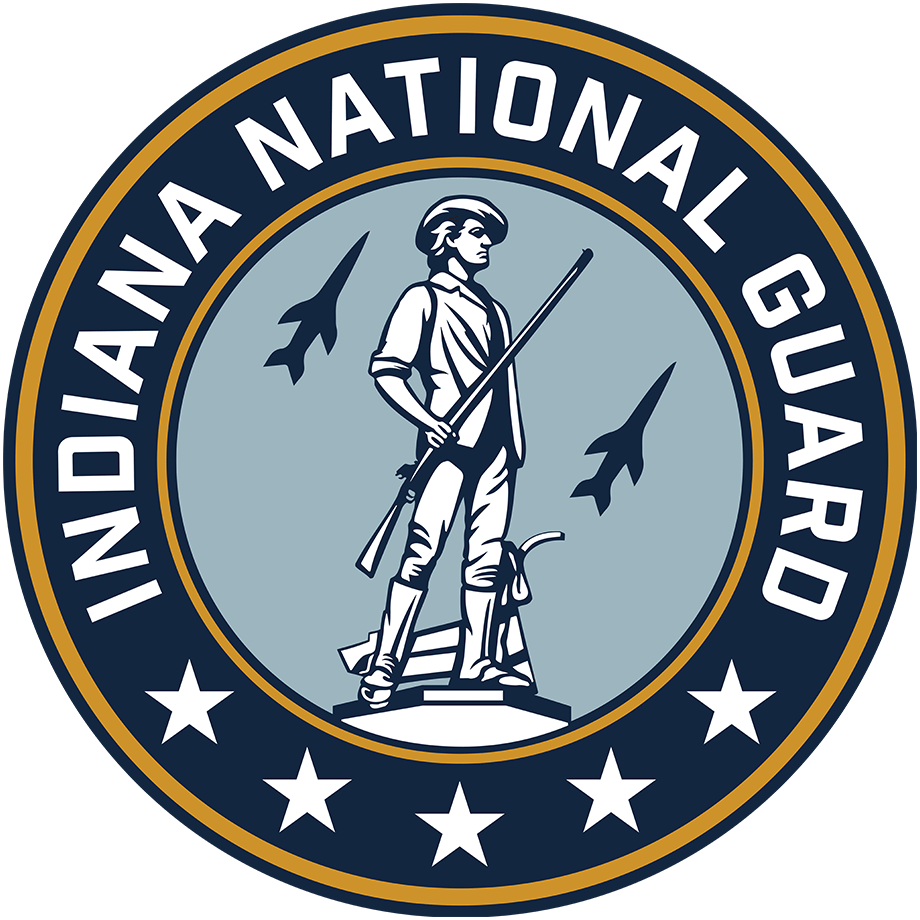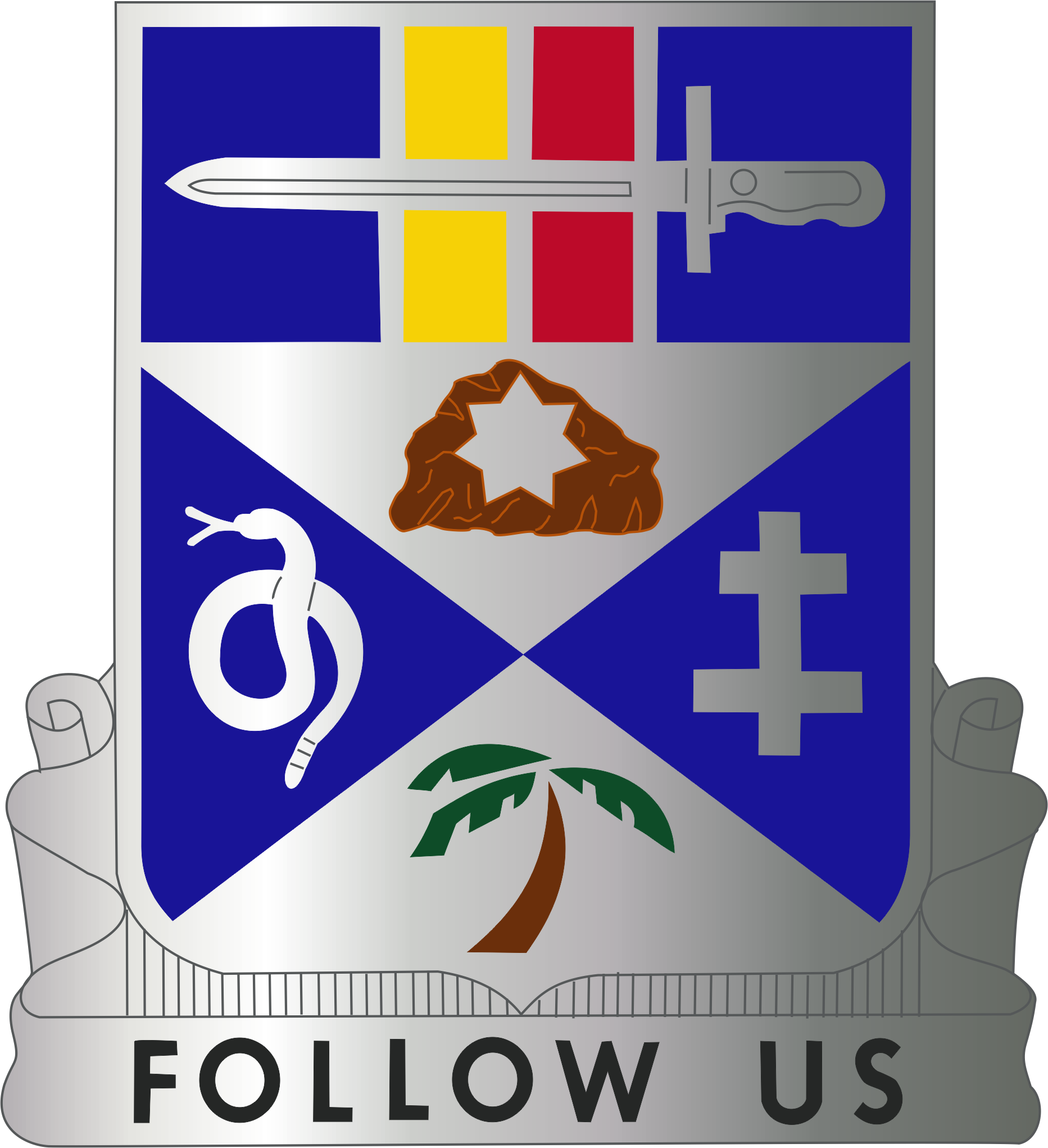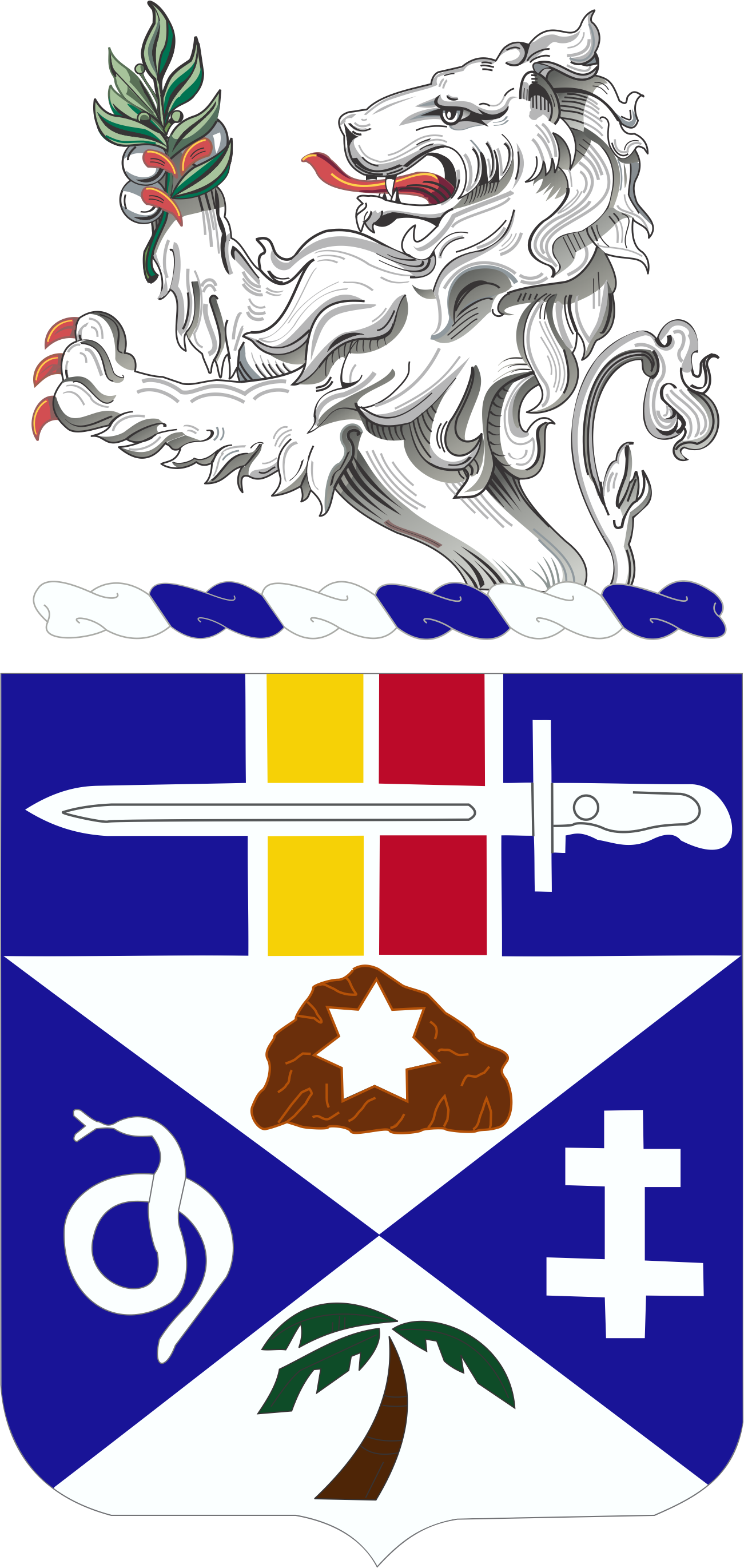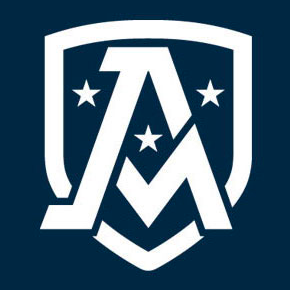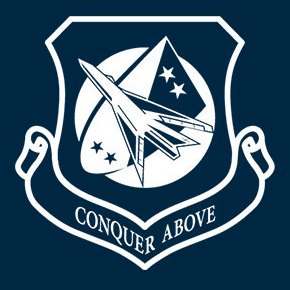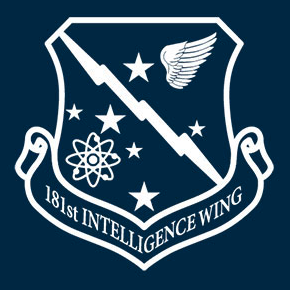INARNG HOME
MOBILIZATION VOLUNTEER PORTAL
SOLDIER FAMILY READINESS
IN YOUR COMMUNITY
ALUMNI RELATIONS
QUICK LINKS
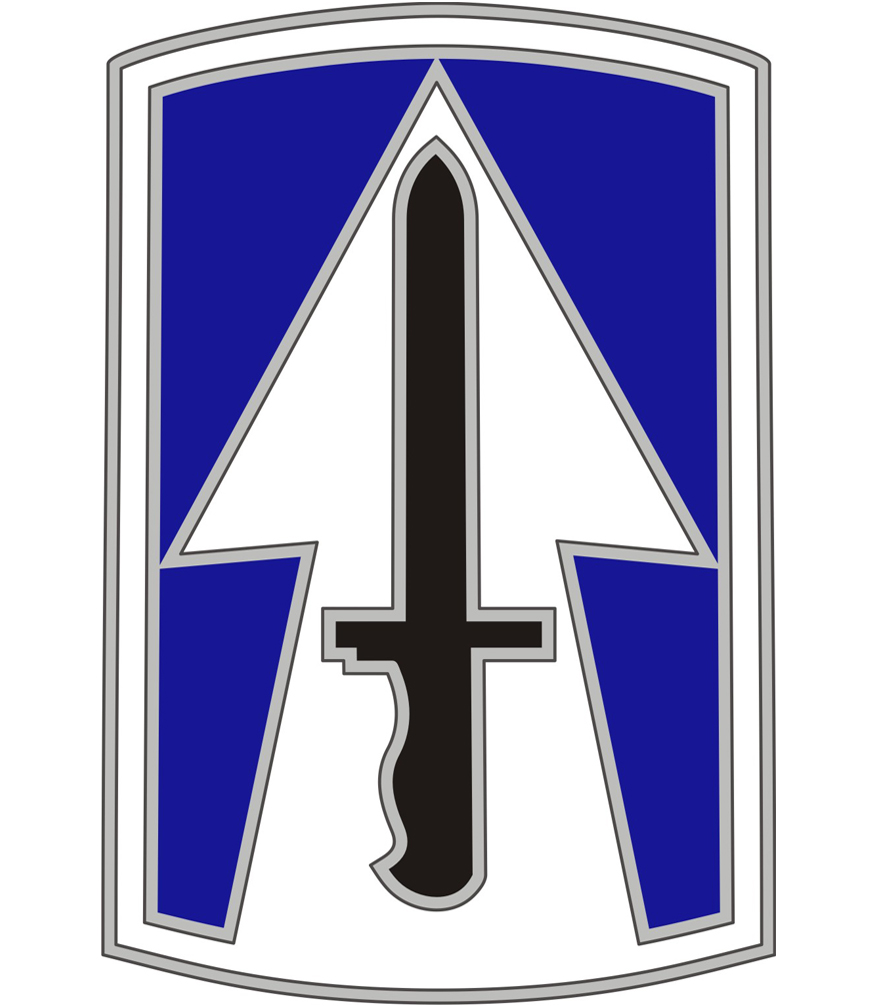

Active: 1963 to present
Designated: 76th Infantry Brigade, March 21, 1995
Redesignated: 76th Infantry Brigade Combat Team, April 24, 2008.
Unit Nicknames: Nighthawks, Blue Devils
Unit Motto: “Point the Way”
Home Station: Lawrence
DESCRIPTION: A silver metal and enamel device consisting of a red arrowhead bearing a silver fleur-de-lis superimposed by two diagonally crossed silver bayonets, on a blue scroll at the top "POINT THE WAY" in silver. SYMBOLISM: Blue is associated with Infantry units. The arrowhead, highlighting the unit's motto, is red for the Brigade's war service. The fleur-de-lis symbolizes their assault landing in France during World War II. The bayonets, which reflect the unit's mission, show military preparedness and are crossed to denote strength and cooperation. BACKGROUND: The distinctive unit insignia and shoulder sleeve insignia were originally approved for the 76th Infantry Brigade on March 21, 1995 and were redesignated for the 76th Infantry Brigade Combat Team on April 24, 2008. Learn more about the origins of the brigade's famous patch. History of the 76th patch (PDF).
Source: Department of the Army, The Institute of Heraldry
About the Nighthawk Brigade
Mission, History and Units
Units of the 76th IBCT "Nighthawk Brigade" headquartered in Lawrence comprise the roots of the Indiana Army National Guard. The 1-151st and 2-151st Infantry Regiments can trace their heritage back to 1811 and the Battle of Tippecanoe, and their lineage back to 1846 and the 2nd Regiment, Indiana Volunteers. The brigade's proud heritage is carried forward by the dedicated soldiers who serve across the state.
- 76th Infantry Brigade Combat Team
The “Nighthawk Brigade,” as the 76th Infantry Brigade Combat Team is known, is one of three brigades under the 38th Infantry Division, Indiana Army National Guard. The brigade’s headquarters is located in the city of Lawrence, Ind. near Indianapolis. Active since 1963 in stabilization efforts in Europe and conflicts in the Middle East, in 2018 the 76th IBCT stepped into an historic role for the National Guard when it became the main task force for the U.S. Army’s Pacific Pathways exercises in the Indo-Pacific region.
Units
- Headquarters and Headquarters Company (HHC), 76th IBCT, Lawrence
- Detachment 1, Headquarters and Headquarters Battalion (HHB) 1-163 Field Artillery (FA), Lawrence
- 1st Battalion, 293rd Infantry Regiment, Fort Wayne
- 1st Battalion, 151st Infantry Regiment, Columbus
- 2nd Battalion, 151st Infantry Regiment, South Bend
- 1st Squadron, 152nd Cavalry Regiment (CAV), New Albany
- 1st Battalion, 163rd Field Artillery Regiment (FA), Evansville
- 113th Brigade Support Battalion (BSB), Muncie
- 776th Brigade Engineering Battalion (BEB), Lawrence
Mission
To provide command, control, and supervision of the operation of the brigade and attached units. The Headquarters and Headquarters Company (HHC) also provides operating personnel to support functional requirements for the headquarters.
History
The roots of the 76th Infantry Brigade, Indiana Army National Guard, reach back to 1917, and the first months of America’s military buildup for the First World War. To supplement the Regular Army, Congress approved the formation of 17 new National Guard divisions numbered 26 through 42.
The National Guards of the states of Indiana, Kentucky and West Virginia were chosen to provide units for the 38th Division. That division was organized according to prevailing American military doctrine as a “square” division of two brigades and four infantry regiments. The 149th Infantry from Kentucky and the 150th Infantry from West Virginia formed the 75th Brigade, and the 151st and 152nd of Indiana formed the 76th Brigade. The 38th Division, with its two component regiments, assembled at Camp Shelby, Mississippi where it remained for the duration of the war, having never been deployed to the battlefields of France. In 1919, the division was released from federal service. The component units of the 38th Division returned to their respective states, and during the next two decades, the 76th Brigade remained an Indiana National Guard unit, composed of the 151st and 152nd Infantry. The Brigade was under state control for over two decades, and fulfilled its state mission while remaining a force capable of federal service if the need arose.
World War II
With the outbreak of World War II in 1939, the Army again called upon the National Guard to supplement the regular forces. In January 1941, the 38th Division was activated for federal service. The states of Indiana, Kentucky and West Virginia again supplied 75th and 76th Brigades, with the same “square” organizational structure that had been used in World War I. However, during the years between the wars, Army doctrine shifted from the “square” division of four regiments and two brigades to a “triangular” division of three regiments, thus eliminating the brigade as a component of the division. This re-organization of the 38th Division was carried out in 1942. The 150th Infantry of the West Virginia National Guard was detached from the division, and the 75th and 76th Brigades were abolished. The 38th Division went on to fight with distinction in the Philippines as the “Avengers of Bataan,” but the 76th Brigade had ceased to exist as an identifiable military organization.Post World War II
After World War II, the 38th Division returned to its peacetime duties as a state-controlled military force of Indiana and Kentucky. The “triangular” organization was retained through the 1950s, with the 149th Infantry in Kentucky, and the 151st and 152nd Infantries in Indiana. In the early 1960s, the Army began the Reorganization Objective Army Division (ROAD) project. This initiative was designed to create a more flexible conventional response for future conflicts, and re-introduced the brigade as an organizational component of the division.The 38th Infantry Division began its reorganization in 1963 with the creation of a 1st and 2nd Brigade. The 1st Brigade was re-named the 76th Brigade in 1965, thereby restoring for the first time in two decades the designation of one of the original brigades formed in 1917. In 1966, the 76th Brigade headquarters was located in Columbus, Ind., in 1969 in Edinburgh, Ind., and in 1977 relocated to Bedford, Ind., where it would remain for the next seven years. During that time, the 76th Brigade was a component of the 38th Infantry Division, and remained under state command.
Modern Operations
- By the early 1990s, the collapse of communism, the disintegration of the threat of the Soviet Union in Europe, and the first Gulf War caused the U.S. Department of Defense to review the organization and role of the various divisions of the National Guard. Concluding that a smaller, lighter force was more appropriate to the strategic defense needs of the United States, the Army announced the creation of 15 “enhanced” or “separate” brigades from existing Army National Guard units. Separate brigades would operate independently of a division, and would have organic combat support and combat service support elements that would enable a more robust mission performance. The separate brigades would also receive more funding, equipment and training to create smaller but more flexible units that could be rapidly mobilized and deployed.
- The new Separate Brigade, nicknamed the “Nighthawks,” began the difficult and challenging task of building a totally new military organization, absorbing new equipment and personnel, and learning and applying new doctrine in the light of a changing strategic situation. Initial focus was on preparation for deployment to the Joint Readiness Training Center (JRTC) at Fort Polk, Louisiana. The Nighthawks went to JRTC in the summer of 2000, and were one of the first new separate brigades to successfully complete that rigorous training. (The 76th IBCT would again train at JRTC in the summer of 2017.)
- In 2001, the 76th IBCT supported the U.S. Army’s stabilization missions in Bosnia and Kosovo. The brigade sent the 293rd Infantry Regiment to Kuwait in 2003 to set up security for a newly constructed support base, and in 2003, two infantry battalions were activated and deployed to support Operation Iraqi Freedom. In the spring of 2004, the Nighthawks were mobilized for deployment to Afghanistan for service in Operation Enduring Freedom.
- During the summer of 2004, under the leadership of Brigadier General Richard Moorhead, the Nighthawks mobilized and trained at Camp Atterbury, Indiana, and elements including 300 soldiers from the 113th Support Battalion, 151st Infantry Regiment, 38th Military Police Company and the 1438th Transportation Company deployed to Afghanistan. There the brigade formed the core of Coalition Joint Task Force Phoenix III. The mission for that Task Force was to train, mentor, and assist the Afghan National Army to restore the rule of law and civil society.
Sources and Further Reading
- Mahon, John K. and Romana Danysh. Army Lineage Series: Infantry, Part I: Regular Army: ROAD and Flexible Response. U.S. Army Center for Military History Publication, 1972.
- Indiana National Guard History
- 1st Battalion, 293rd Infantry Regiment
Active: 1846 as the 1st Regiment, Indiana Volunteers
Decorations: Philippine Presidential Unit Citation, Oct. 17, 1944 to July 4, 1945
Unit Nickname: Nightfighters
Unit Motto: “Follow Us"
Home Station: Fort WayneBLAZON: SHIELD: Per saltire argent and azure, in pale a rock proper (shades of brown) bearing a mullet of seven points of the first above a palm tree with three leaves proper, in dexter fess a coiled rattlesnake and in sinister fess the Lorraine Cross, all of the first, on a chief of the second a pale per pale Or and gules, fimbriated of the first, and overall a bayonet fesswise of the like. CREST: That for the regiments and separate battalions of the Indiana Army National Guard: On a wreath of the colors argent and azure, a demi-lion rampant argent, holding in dexter paw a laurel branch vert. MOTTO: FOLLOW US. SYMOBLISM: SHIELD: Blue and white are the colors used for Infantry. The shield is divided into four parts to symbolize four wars. The snake, from the arms of Mexico, represents the Mexican War. The rock, symbolic of Chickamauga, alludes to the Civil War. The points of the mullet represent seven battle honors. The Lorraine Cross symbolizes World War I. The palm tree is symbolic of the Pacific Theater, World War II. The three leaves represent three battle honors awarded the unit. The chief in the colors of the Philippine Presidential Unit Citation commemorates that decoration awarded the unit. The bayonet, always associated with Infantry, denotes the coverage and fighting capabilities of the unit. CREST: The crest is that of the Indiana Army National Guard. BACKGROUND: The coat of arms was approved Oct. 22, 1963 and amended to correct the blazon, April 19, 1978.
Source: Department of the Army, The Institute of Heraldry
Units
- Headquarters and Headquarters Company (HHC), 1-293 Infantry, Fort Wayne
- Detachment 3, Headquarters and Headquarters Battalion (HHB) 1-163 Field Artillery (FA), Fort Wayne
- A Company, 1-293 Infantry, Hartford City
- B Company, 1-293 Infantry, Fort Wayne
- C Company,1-293 Infantry, Angola
- D Company, 1-293 Infantry, Bluffton
- H Company, IN Forward Support Company (FSC), Fort Wayne
Mission
To close with and destroy enemy forces using fire, maneuver and shock effect, or to repel his assault by fire and counterattack. The Headquarters and Headquarters Company (HHC) provides command, control and supervision of tactical operations of the battalion units and directs organic core systems and capabilities in the organization echelons based on primary mission orientation. The Headquarters (HQ) directly controls the battalion's reconnaissance effort and mortar platoon. The HQ provides missions to the battalion sniper squad. The HQ plans and executes full spectrum operations at the direction of the Infantry Brigade Combat Team (IBCT) HQ and filters to essential layers and elements based on primary mission to insure rapid response, robustness and combined arms teamwork. The HHC maintains the responsibility and capability of augmenting any subordinated elements within the battalion to meet mission requirements as directed by higher headquarters. The A/B/C/D Company mission is to close with the enemy by means of fire and maneuver to destroy or capture, or to repel his assault by fire, close combat and counterattack. D Company also provides anti-armor fire support for the rifle companies.
History
Mexican-American War
The 1st Battalion, 293rd Infantry Regiment carries a rich and honorable heritage. In 1846, existing companies of militia were formed as the 1st Regiment, Indiana Volunteers of the Indiana Brigade to answer the call to halt Mexican aggression along the border.Serving under, then Brig. Gen. Zachary Taylor, the citizen soldiers from Indiana fought a desperate battle at Buena Vista. The Indiana Regiment found itself in the farthest forward position of the American line as two Mexican Divisions launched their assault. For almost an hour, the Hoosier soldiers held the line against repeated attacks by Gen. Santa Anna's soldiers. The outcome of the fierce battle was yet to be decided when, along with the 1st Mississippi Rifles, the Hoosiers counterattacked under the leadership of Col. Jefferson Davis. The Mexican attack was halted and ended any further threat to the lower Rio Grande region. It would be fewer than 15 years later when Indiana's soldiers would fight not with, but against, both Mississippi and Davis.
Civil War
In April 1861, Indiana again heard the call to arms as the nation faced a bloody civil war. Reformed as the 9th Indiana Volunteer Infantry Regiment from companies of militia from Northern Indiana, these soldiers went on to fight in 10 major Civil War campaigns. Shiloh, Chickamauga, Chattanooga, Franklin, Nashville and Atlanta are some of the battlefields where the courage and tenacity of our soldiers helped the Union restore the nation and win freedom for all of its citizens.World War I and World War II
Northern Indiana soldiers continued to serve their nation and state. The unit served again in World War I, but it was in 1945 that saw some of the fieriest fighting of the unit's history.Serving as the 3rd Battalion, 152nd Infantry, the regiment as part of Indiana's 38th Infantry Division would fight its way through New Guinea, Leyte and Luzon. It helped the Division earn the nickname “The Avengers of Bataan” as the regiment fought across the base of the Bataan peninsula. The soldiers cleared Route 7, fought for 14 days against fierce Japanese resistance to take Zig Zag Pass, and seized bloody Woodpecker Ridge. Once again, the courage of Hoosiers helped the nation win a desperate struggle.
In 1947, the unit's name was changed again to the 1st Battalion, 293rd Infantry Regiment headquartered in Fort Wayne, Ind. Though serving under new colors, the courage and dedication to serving the community, state and nation remains the same. In peace or war, the Nightfighter Battalion stands ready to serve as the vanguard of the 76th Infantry Brigade.
Modern Operations
- Soldiers from 1-293rd Infantry deployed to fight in the Global War on Terror in Kuwait and Iraq in 2003, making the 1-293rd IN the first Army National Guard Infantry Battalion alerted and deployed into active ground combat since the Korean War.
- 2005: 1-293rd Nightfighters mobilized to Mississippi during Operation Vigilant Relief in support of the U.S. Gulf Region states ravaged by Hurricane Katrina.
- 2017: 1-293rd conducted a rotation at the Joint Readiness Training Center (JRTC) in Fort Polk, Louisiana.
- 2018: 1-293rd deployed to Australia during Operation Hamel, a training exercise that was part of Pacific Pathways 2018.
- June 2020: Soldiers of the 1-293 served with Task Force Indiana in support of Operation D.C. Guardian.
- January 2021: The Nightfighters returned to our Nation’s Capital in to provide security on the Whitehouse grounds and Capitol Building in the days surrounding the 45th Presidential Inauguration.
- 1st and 2nd Battalions, 151st Infantry Regiment
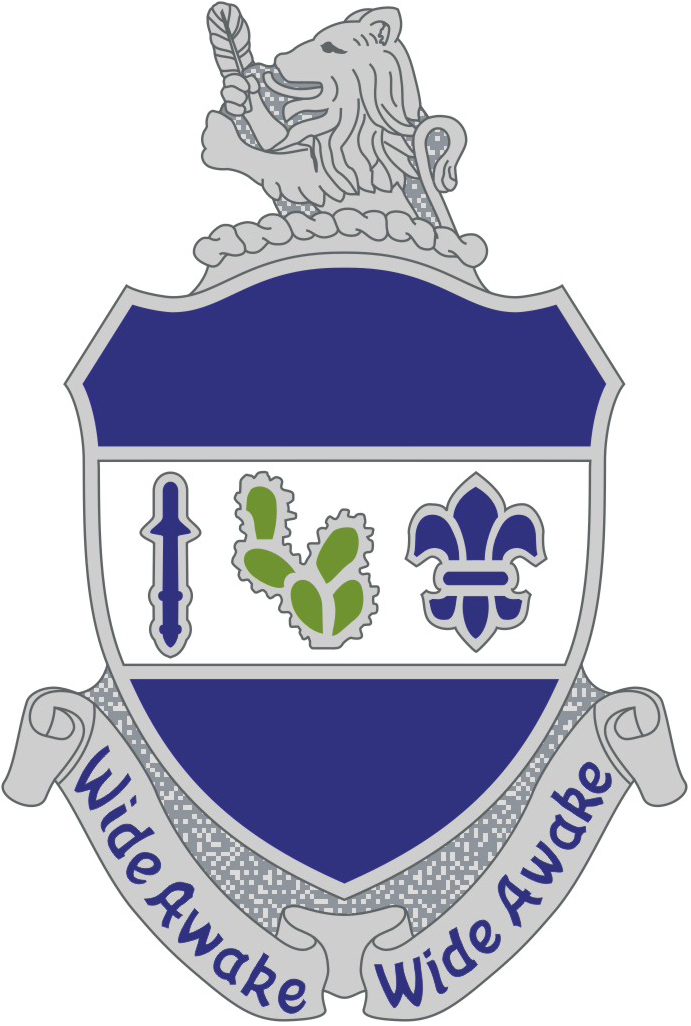

Active: Lineage of the 1-151st and 2-151st goes back to the 2nd Regiment, Indiana Volunteers, 1846
Decorations: Philippine Presidential Unit Citation, Oct. 17, 1944 to July 4, 1945
Unit Nickname: Spartans
Unit Motto: "Wide Awake! Wide Awake!"BLAZON: SHIELD: Azure, on a fess argent a prickly pear cactus proper between a sheathed Roman sword palewise and a fleur-de-lis of the first. CREST: That for the regiments and separate battalions of the Indiana Army National Guard: On a wreath of the colors argent and azure, a demi lion rampant argent, holding in dexter paw a laurel branch vert. MOTTO: Wide Awake – Wide Awake. SYMBOLISM: The shield is blue for infantry. The fess charged with the Roman sword, cactus and fleur-de-lis represent service in the War with Spain, on the Mexican Border, and in France during World War I. BACKGROUND: The coat of arms was approved Feb. 1, 1932.
Source: Department of the Army, The Institute of Heraldry
Founding
Both the 1st Battalion (1-151 IN) and 2nd Battalion (2-151 IN) are elements of the 76th Infantry Brigade Combat Team. The 151st Infantry Regiment traces its heritage back before Indiana became a state in 1816. William Henry Harrison, Governor of the Indiana Territory, organized an army of about 1,000 men made up from volunteers of Southern Indiana counties, including the Indiana Militia, Kentucky Mounted Riflemen, and the 4th U.S. Infantry Regiment. They left the Territorial Capitol in Vincennes and moved north along the Wabash River to confront Tecumseh and his Shawnee Confederation. While Tecumseh was away recruiting more tribes, Harrison arrived with his army at a site near present-day Lafayette, Ind. During the night of Nov. 6, 1811, the Shawnee Confederation attacked the army in camp. After a two hour struggle to breach the American perimeter, the Confederation withdrew. To prevent a sneak attack, on the following night (Nov. 7, 1811), the soldiers shouted “Wide Awake!” to each other to remain alert, which became the origins of the unit's motto.Units of the 1-151st Infantry
Home Station: Columbus
Lineage and Honors- Headquarters and Headquarters Company (HHC), 1-151st Infantry, Columbus
- Detachment 2, Headquarters and Headquarters Battalion (HHB) 1-163rd Field Artillery (FA), Columbus
- A Company, 1-151st Infantry, Greenfield
- B Company, 1-151st Infantry, Martinsville
- C Company, 1-151st Infantry, Stout Field
- D Company, 1-151st Infantry, Washington
- G Company, 113th Brigade Support, Bedford
- Company C, 2-134th Infantry Regiment (Airborne), Seymour
Units of the 2-151st Infantry
Home Station: South Bend
Lineage and Honors- Headquarters and Headquarters Company (HHC), 2-151st Infantry, South Bend
- Detachment 4, Headquarters and Headquarters Battalion (HHB), 1-163rd Field Artillery (FA), South Bend
- A Company, 2-151st Infantry, Gary, Limited Aviation Support Facility (LAASF)
- B Company, 2-151st Infantry, Logansport
- C Company, 2-151st Infantry, Warsaw
- Detachment 1 ,Company C, 2-151st Infantry, Peru
- D Company, 2-151st Infantry, Frankfort
- J Company, 113th Brigade Support Battalion (BSB), South Bend
Mission
To close with and destroy enemy forces using fire, maneuver and shock effect, or to repel his assault by fire and counterattack. The Headquarters and Headquarters Company (HHC) unit mission is to provide command, control and supervision of tactical operations of the battalion units. The HHC directs organic core systems and capabilities in the organization echelons based on primary mission orientation. The Headquarters (HQs) directly controls the battalion's reconnaissance effort and mortar platoon. The HQs provides missions to the battalion sniper squad. The HQs plans and executes full spectrum operations at the direction of the Infantry Brigade Combat Teams (IBCT) HQs and filters to essential layers and elements based on primary mission to insure rapid response, robustness, and combined arms teamwork. The HHC maintains the responsibility and capability of augmenting any subordinated elements within the battalion to meet mission requirements as directed by higher headquarters. The A/B/C/D Company mission is to close with the enemy by means of fire and maneuver to destroy or capture, or to repel his assault by fire, close combat and counterattack. D Company also provides anti-armor fire support for the rifle companies.
History
A person reading the historical lineage of the 151st Infantry Regiment will quickly realize the regiment is credited with 24 campaigns during the Civil War. What is not readily apparent is the lineage combines the Civil War accomplishments of the 7th, 10th and 11th Indiana Volunteer Infantry Regiments. … After three years of active campaigning the 7th and 10th mustered out in September 1864, while the 11th remained active to the end of the war, mustering out in May 1865. The accomplishments of each regiment were decisive to the conduct of several campaigns, shaped the successful outcome of the Civil War, and firmly established the reputation of Hoosiers as determined and reliable Citizen Soldiers.
—Maj. Harold “Allen” Skinner, Commander, 138th Military History Detachment. “The Civil War Lineage of the 151st Infantry Regiment”
Source: Department of the Army Lineage and Honors certificate of the 151st Infantry Regiment, p. 3.Mexican-American War
- June 24, 1846: Constituted as the 2nd Regiment of Indiana Volunteers and organized from existing independent companies as follows: Sullivan Volunteers, Clay County Volunteers, Greene County Volunteers, Lawrence Greys, Hoosier Boys, Washington Riflemen, Posey Guards, Indiana Riflemen, Spencer Greys and Lanesville Legion.
- June 26, 1846: Mustered into federal service at New Albany, Ind.; mustered out June 21-28, 1847 at New Orleans, Louisiana, and reorganized as independent companies in home state.
- June 1847: The First Regiment mustered into federal service at New Albany, Ind. The regiment fought at Vera Cruz and Buena Vista, pushing back the border of Mexico and helping forge the shape of America.
Civil War
With the fall of Fort Sumter, the 151st IN mustered to preserve the union and the freedom and values we Hoosiers hold sacred. Antietam, Gettysburg, Manassas, Chancellorsville, and Cold Harbor are just a few of the battles that shook the nation.
- April 26, 1861: Independent companies in central and southern portions of state consolidated to form 7th (Col. Ebenezer Dumont), 10th (Col. Joseph J. Reynolds), and 11th (Col. Lewis “Lew” Wallace) Regiments Indiana Volunteers, and mustered into federal service (American Civil War). Mustered out Sept. 23, 1864 (veterans and recruits mustered out July 12, 1865 with 20th Indiana Volunteer Infantry). 19th Indiana Infantry Regiment (Col. Mahlon D. Manson) mustered into federal service on Sept. 18, 1861, mustered out Sept. 19, 1864, mustered out July 26, 1865, after having reenlisted Jan. 4, 1864.
- May 27, 1882: Reorganized as the 2nd Regiment, Indiana Veteran Legion, from existing independent companies, organized 1877-1882 as follows: Indianapolis Light Infantry, McKeen Cadets (Terre Haute), Evansville Rifles, Richmond Light Guard, Sherman Guards (Frankfort), Waterloo Rifles, McCune Cadets (Rockville), Remington Guards, South Bend Light Infantry, Miller Grenadiers (Richmond), Pulaski County Blues and Lebanon Rifles. Reorganized Nov. 1, 1884, with headquarters at Indianapolis. Reorganized in 1892 as the 1st Regiment, Indiana Legion, after exchange of companies accomplished 1890-1892. (Indiana Legion redesignated Indiana National Guard on March 5, 1895.)
Spanish-American War
As America healed from its wounds after the Civil War, The First Indiana Regiment responded along with other Indiana Guardsmen when the nation called. Indiana was the first of any state to take the field during the Spanish-American War.
- May 12, 1898: Redesignated 159th Indiana Volunteer Infantry and mustered into federal service (Spanish-American War). Assigned to 1st Brigade, 2nd Division, II Army Corps and stationed at Camp Alger, Virginia. Marched to Camp Meade, Pennsylvania via Thoroughfare Gap and mustered out Nov. 23, 1898.
- July 20, 1900: Reorganized in south and southwestern Indiana as the 1st Infantry, Indiana National Guard with companies at Vincennes, Terre Haute, New Albany, Washington, Evansville, Madison, Bloomington, Greencastle and Martinsville.
World War 1 - World War II
June 27-July 9, 1916: Mustered into federal service (Mexican Border War) and stationed at Llano Grande, Texas; mustered out March 14, 1917 at Fort Benjamin Harrison, Indiana.
Aug. 5, 1917: On the eve of World War I, the 151st Infantry Regiment was rafted into federal service at Indianapolis mustered at Camp Shelby, Mississippi assigned to the 38th Division on Oct. 1, 1917. Training at Camp Shelby, the unit deployed to France in October 1918, where its soldiers reinforced the ranks of front-line combat units. Skeletonized during Nov. 1918 in France and demobilized March 8, 1919 at Camp Zachary Taylor, Kentucky.
June 30, 1921: Reorganized in central Indiana and federally recognized with headquarters at Indianapolis.
Jan. 17, 1941: Inducted into federal service (World War II) at Indianapolis. (On Feb. 10, 1941, the 38th Division was redesignated the 38th Infantry Division) Inactivated Nov. 9, 1945 at Camp Anza, California. Reorganized and federally recognized July 29, 1947 with headquarters at Indianapolis.
Reorganizations
- Feb. 1, 1959: Relieved from the 38th Infantry Division and reorganized as the 151st Infantry, a parent regiment under the Combat Arms Regimental System.
- In 1977, the regiment was organized into two battalions, elements of the 38th Infantry Division. Both the 1st Battalion (1-151 IN) and 2nd Battalion (2-151 IN) became elements of the 76th Infantry Brigade Combat Team.
Vietnam War
Elements of the 151st Regiment served in the Vietnam War. Company D (Ranger) “Delta Company” was the only National Guard Infantry unit to serve intact, and earned more medals in 1969 than any other Army infantry company during a one-year period. More than 12,200 Army National Guardsmen in 20 units from 17 states were mobilized for service on May 13, 1968. Eight units deployed to Vietnam and over 7,000 Army Guardsmen served in the war zone. Indiana Rangers arrived in Vietnam in Dec.1968, and as part of the II Field Force were assigned reconnaissance and intelligence-gathering missions. Operating deep in enemy territory, Ranger patrols engaged enemy units while conducting raids, ambushes and surveillance missions. Delta Company achieved an impressive combat record during its tour in Vietnam; unit members were awarded 510 medals for valor and service.
Source: National Guard Bureau, The Indiana Guardsman, Vol. 6, Issue 2, p. 23. June 2010.Modern Operations
Elements of the 151st have deployed for the NATO Stabilization Force in Bosnia and Herzegovina (SFOR), Operation Iraqi Freedom and Operation Enduring Freedom in Afghanistan:
- March 2007-2008: Fox Company of 2-151 IN deployed to Iraq in support of Operation Iraqi Freedom.
- 2009-2010: Alpha and Bravo Companies deployed to Afghanistan in support of Operation Enduring Freedom.
- 2022-2023: HHC and Bravo Company deployed to Kosovo in support of the NATO led Regional Command-East mission of KFOR 31. During this mobilization, the units took a major role in Operation Joint Guardian (Changed to Joint Enterprise by NATO).
Sources and Further Reading
- Pratt, William D. “A History of the National Guard of Indiana, from the Beginning of the Militia System in 1787 to the Present Time, Including the Services of Indiana Troops in the War with Spain.” W. D. Pratt, Printer and Binder, Indianapolis 1901; Palala Press, March 2, 2018.
- Skinner, Harold Allen. “The Civil War Lineage of the 151st Infantry Regiment,” Indiana National Guard, 2013. PDF
- Indiana State Library: “Ebenezer Dumont Papers.”
- “General Cullum's Biographical Register of the Officers and Graduates of the United States Military Academy” (“Cullum’s Register.”)
- Indiana Historical Society: “Lew Wallace Collection, 1799–1972 (Bulk 1846–1905).”
- Indiana Historical Society: “General Mahlon D. Manson Family Papers, 1848–1910.”
- 1st Squadron, 152nd Cavalry Regiment

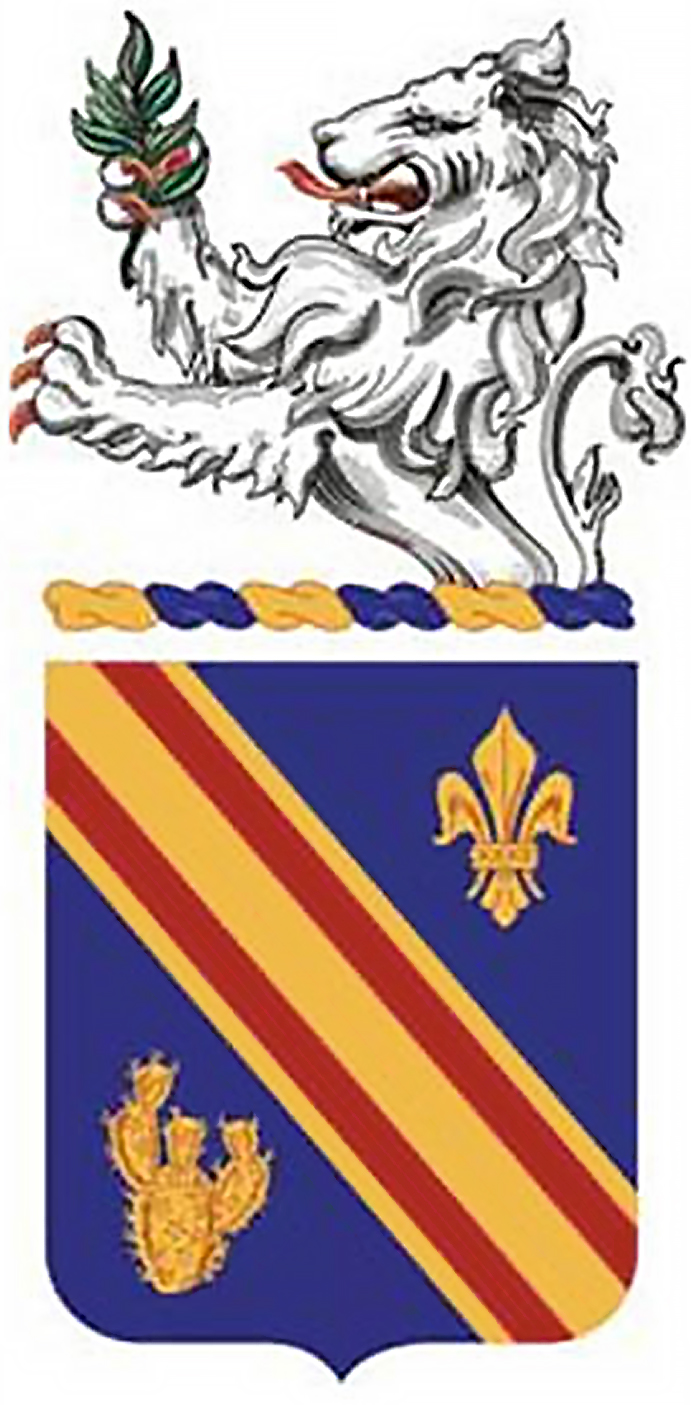
Active: June 24, 1846 (as Third Indiana Volunteer Infantry)
Decorations: Philippine Presidential Unit Citation, Oct. 17, 1944 to July 4, 1945
Unit Nickname: Ghostriders
Unit Motto: "Fit to Fight"
Home Station: New AlbanyBLAZON: SHIELD: Azure, on a bend between a fleur-de-lis and a prickly pear cactus Or, two cotises gules. CREST: That for the regiments and separate battalions of the Indiana Army National Guard: From a wreath Or and azure a demi-lion rampant argent holding in dexter paw a laurel branch vert. MOTTO: FIT TO FIGHT. SYMBOLISM: SHIELD: The shield is blue for Infantry, the unit’s original designation. The red cotises on the gold band are Spanish colors, representing the continental service of the organization during the Spanish American War. The cactus and fleur-de-lis represent duty on the Mexican Border and overseas respectively. CREST: The crest is that of the Indiana Army National Guard. BACKGROUND: The coat of arms was approved for the 152nd Infantry Regiment on Oct. 15, 1929 and redesignated for the 152nd Cavalry Regiment on Sept. 1, 2007, with the blazon and symbolism updated. COLLAR INSIGNIA: Two crossed sabers in scabbards, cutting edge up, 11/16 inch in height, of gold color metal. The cavalry insignia was adopted in 1851. Officers and enlisted personnel assigned to cavalry regiments, cavalry squadrons or separate cavalry troops are authorized to wear the cavalry collar insignia in lieu of their insignia of branch when approved by the MACOM (major command) commander.
Source: Department of the Army, The Institute of Heraldry
Units
- Headquarters and Headquarters Troop (HHT), 1-152nd CAV Squadron, New Albany
- Detachment 5, Headquarters and Headquarters Battalion (HHB) 1-163rd Field Artillery (FA), New Albany
- A Troop, 1-152nd CAV Squadron, Madison
- B Troop, 1-152nd CAV Squadron, Connersville
- C Troop, 1-152nd CAV Squadron, Salem
- D Company, 113th Brigade Support Battalion (BSB), Scottsburg
Mission
On order, the 1st Squadron 152nd Cavalry Regiment is postured to provide relevant and ready forces to the Governor of Indiana and Combatant Commanders, in defense of our State and Nation. The 1-152nd Cavalry conducts reconnaissance and surveillance in support of the development of the brigade's situational awareness and knowledge in the area of operations. Squadron operations empower the brigade to anticipate, forestall and dominate threats, ensuring brigade mission accomplishment through decisive action and freedom of maneuver. The Headquarters and Headquarters Company (HHC) unit mission is to provide command, control and supervision of the tactical operations of the Reconnaissance Squadron and attached units; unit administration and logistical support for the squadron staff sections; and administrative and medical support to organic and attached units. The A/B/C Company mission is to conduct reconnaissance and surveillance supporting the development of the brigade's situational awareness and knowledge in the area of operations.
History
Mexican-American War
Organized on June 24, 1846, today's 1st Squadron 152nd Cavalry Regiment traces its roots to the counties of Southern and Central Indiana. Originally designated the Third Indiana Volunteer Infantry during the Mexican-American War, the regiment rests on the foundation of a proud battle history and continues to prepare its troops to deploy when called upon to again defend the nation.The regiment mustered into federal service on June 26, 1846 during the Mexican-American War as volunteers coming to the aid of the free people of Texas who desired to become an American state. These Hoosier soldiers exemplified duty, honor and courage, and helped forge the ideals of liberty of a growing nation as it shrugged off old boundaries and spread freedom across the expanses of its wilderness. The regiment fought bravely at the battle of Buena Vista under the command of Col. James Henry Lane and Sgt. Maj. Jonathan W. Gordon, and helped ensure the dominance of a free nation over the American Southwest.
After the war with Mexico, the regiment was reorganized into independent companies throughout Southern Indiana. During a period of about 15 years, these independent companies continued to serve Indiana with a multitude of public service and security related missions.
Civil War
On Aug. 6, 1861, independent Southern Indiana companies were organized to form the Sixth and Eighth Indiana Volunteer Infantry Regiments and the Second Indiana Volunteer Cavalry Regiment. Due to re-organization of these independent companies and lateral movement of personnel, today’s 152nd Cavalry can trace its lineage back to all three of these Civil War regiments.The regiment was organized at Madison, Ind., and mustered on Sept. 20, 1861. The regiment mustered out of service on Sept. 22, 1864. Soldiers of the regiment who had unexpired enlistments, and those who re-enlisted, were transferred to 68th Regiment Indiana Volunteer Infantry.
Spanish-American War
The regiment once again mustered into federal service for the Spanish-American War on May 10, 1898 and was re-designated the 158th Indiana Volunteer Infantry. The 158th Regiment of Infantry, Indiana Volunteers, was formed of the 2nd Regiment, Indiana National Guard, and was composed of companies from Indianapolis, Rochester, Frankfort, Franklin, Winchester, Covington, Sheridan, Martinsville, Kokomo and Crawfordsville.The regiment was furloughed for 30 days from Sept. 17 and was finally mustered out and discharged Nov. 4, 1898.
World War I and World War II
The regiment again mustered into federal service on Aug. 5, 1917 and was re-designated the 152nd Infantry assigned to the 38th Division on Oct. 1, 1917 for service in World War I. After World War I, the 152nd Infantry Regiment was inactivated from federal service on March 8, 1919 at Camp Zachary Taylor, Kentucky, and returned to Indiana to resume peacetime operations.The regiment was inducted into federal service on Jan. 17, 1941 for service in the Pacific theater of operations. The regiment set out for the Pacific Theater with a new name, fighting for the first time as the 152nd Infantry, part of the 38th Infantry Division Cyclones. At New Guinea, Leyte and Luzon, they demonstrated their resolve once again, fighting with such tenacity that General Douglas MacArthur himself dubbed the Division the “Avengers of Bataan.” After World War II, the 152nd Infantry Regiment was inactivated from federal service on Nov. 9, 1945 at Camp Anza, California, and returned to Indiana to resume peacetime operations.
Modern Operations
- The regiment was reorganized on Feb. 1, 1959 as a parent regiment under the Combat Arms Regimental System to consist of 1st and 2nd Battle Groups, elements of the 38th Infantry Division.
- The regiment reorganized on Sept. 1, 1994 to consist of the 1st Battalion 152nd Infantry, an element of the 76th Infantry Brigade, and the 2nd Battalion 152nd Infantry, an element of the 38th Infantry Division.
- On Jan. 2, 2003, the 1st Battalion, 152nd Infantry “Avengers” were called to duty in support of Operation Iraqi Freedom. The individual companies within the battalion were pushed out in order to support a variety of organizations, to include 5th Special Forces Group. Finally, on Jan. 12, 2004 the 152nd Infantry Battalion returned home.
- On Sept. 1, 2007, the regiment was re-designated as the 152nd Cavalry Regiment to consist of the 1st Squadron 152nd Cavalry, an element of the 76th Infantry Brigade Combat Team (IBCT), and the 2nd Squadron 152nd Cavalry, an element of the 219th Battlefield Surveillance Brigade (BFSB).
- On Jan, 3, 2008, the 1st Squadron 152nd Cavalry mobilized and deployed to Iraq in support of Operation Iraqi Freedom.
- In 2022, the 1-152nd Cavalry once again answered the nation’s call when it prepared and conducted pre-mobilization training at Ft. Bliss, Texas in the fall and deployed to Egypt in support of the multi-national force observer mission. The unit redeployed in Sept. 2023.
Sources: 76th IBCT; Allison, John. A Brief History of the 158th Indiana Volunteer Infantry
- 1st Battalion, 163rd Field Artillery Regiment
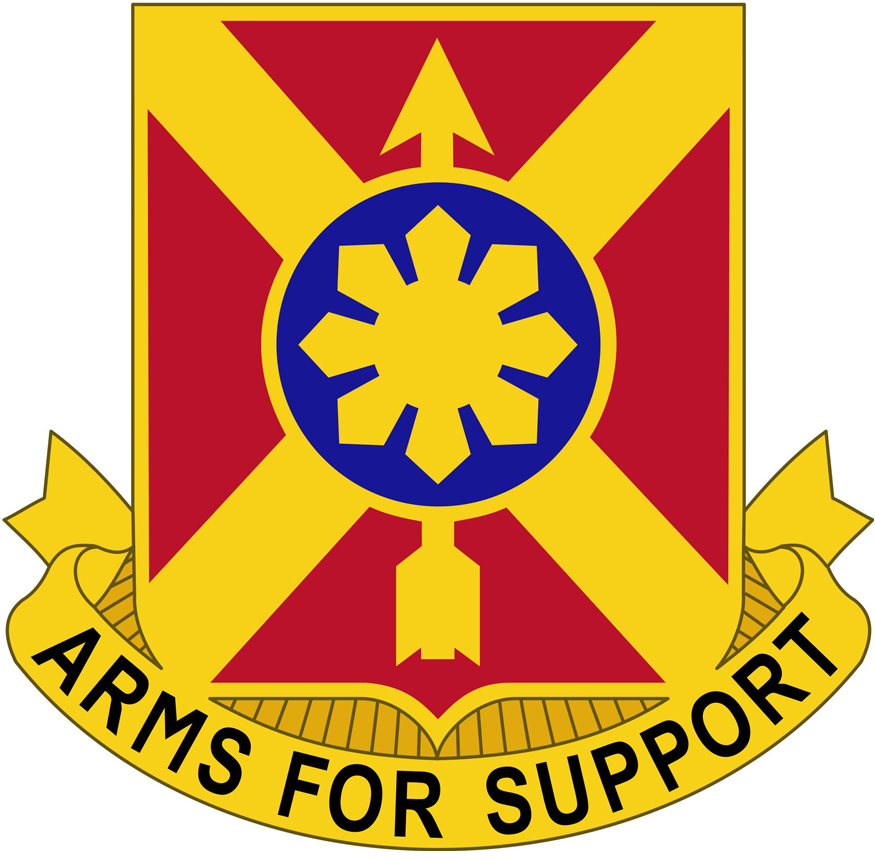
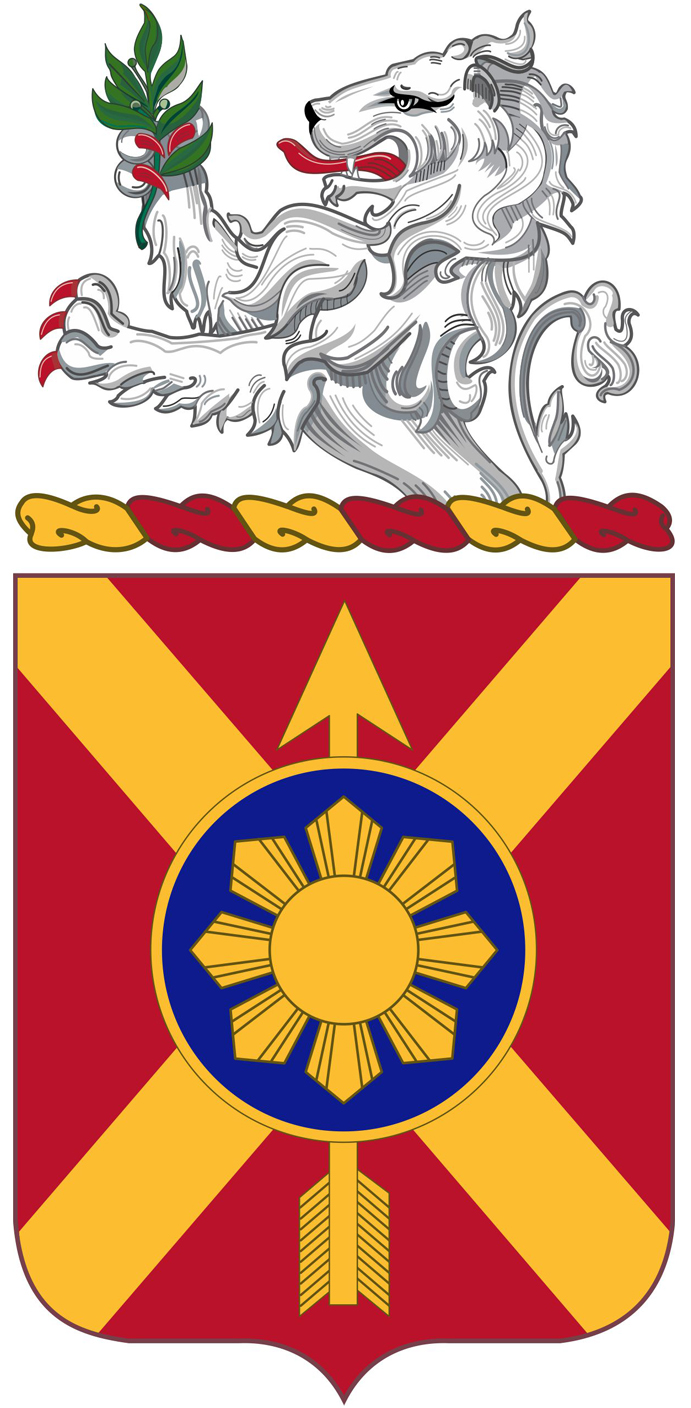
Active: May 1, 1917 as the 2nd Battalion, 4th Infantry;
Decorations: Philippine Presidential Unit Citation, Oct. 17, 1944 to July 4, 1945
Nicknames: River Rats, Red Hawks
Special Designation: River City Red Legs
Unit Motto: "Arms for Support"BLAZON: SHIELD: Gules, a saltire and overall an arrow palewise in pale with point to chief Or, surmounted overall at fess point by a hurt fimbriated and charged with a Philippine sunburst of the second. CREST: That for the regiments and separate battalions of the Indiana Army National Guard: On a wreath of the colors Or and gules, a demi-lion rampant argent, holding in dexter paw a laurel branch vert. MOTTO: ARMS FOR SUPPORT. SYMBOLISM: SHIELD: Scarlet and yellow are the colors used for Artillery units. The Philippine sunburst symbolizes the organization’s Philippine Presidential Unit Citation and alludes to the unit’s World War II campaign participation in New Guinea, Leyte and Luzon. The blue area suggested by the state flag of Indiana also represents the many lakes and streams of the area. The arrow symbolizes the Indian heritage of the state and the unit’s mission of Field Artillery. The heraldic saltire alludes to Indiana’s motto “The Crossroads of America.” CREST: The crest is that of the Indiana Army National Guard. BACKGROUND: The distinctive unit insignia and coat of arms were approved on June 8, 1978.
Sources: 76th IBCT; Department of the Army, The Institute of Heraldry; U.S. Army Center of Military History: The Organizational History of Field Artillery: 1175-2003
Units
- Headquarters and Headquarters Battalion, 1-163rd Field Artillery (FA), Evansville
- A Battery, 1-163rd Field Artillery, Evansville
- B Battery, 1-163rd Field Artillery, Vincennes
- C Battery, 1-163rd Field Artillery, 38th Infantry Division, Indianapolis
- F Company, 113th Brigade Support Battalion (BSB), Evansville
Mission
To destroy, neutralize or suppress the enemy by cannon fires. The Headquarters and Headquarters Battalion (HHB) unit mission is to provide command, control and administrative supervision of organic and attached field artillery units. The A/B Battery, Field Artillery Battalion, 105T (IBCT) and C Battery, Field Artillery Battalion, 155T (IBCT) missions are to destroy, neutralize or suppress the enemy with cannon fire.
History
World War I
The First Battalion, 163rd Field Artillery Regiment was constituted May 1, 1917 as the 2nd Battalion, 4th Infantry and allotted to the Indiana National Guard. The battalion was drafted into federal service Aug. 5, 1917 at Indianapolis, and on Oct. 1, 1917, was converted and redesignated as the 2nd Battalion, 139th Field Artillery and assigned to the 38th Division. On Jan. 16, 1919, the battalion was demobilized at Camp Benjamin Harrison, Ind. The battalion was reorganized and federally recognized on April 12, 1924 with headquarters at Princeton in Southwest Indiana.World War II
As the nation’s forces restructured in anticipation of fighting in World War II, the battalion was inducted into federal service on Jan. 17, 1941 at Princeton, Ind. On Feb. 10, 1942, the battalion was reorganized and redesignated as the 163rd Field Artillery Battalion and assigned to the 38th Division (subsequently the 38th Infantry Division).In Jan.1945, the 1-163rd FA took part in the 38th Infantry Division’s amphibious assault on the island of Luzon, north of the Bataan peninsula in the Southwest Pacific. The same peninsula had been the site of the Bataan Death March, where in May of 1942 over 10,000 captured American soldiers were forced to march roughly 75-90 miles under brutal and inhumane conditions, with many either dying or killed along the way. The fire support they provided the 38th Division during the assault aided them in their mission and ultimately enabled the success of the division’s mission to seal off the peninsula and retake it from the Japanese. Following the victory, General Douglas MacArthur, commander of the American Forces in the Southwest Pacific accorded the 38th Infantry Division the distinction of being the “Avengers of Bataan.”
Sources: 76th IBCT; Sawicki, James A. “Field Artillery Battalions of the U.S. Army” Wyvern Publications, June 1, 1981.
- 113th Brigade Support Battalion (BSB)
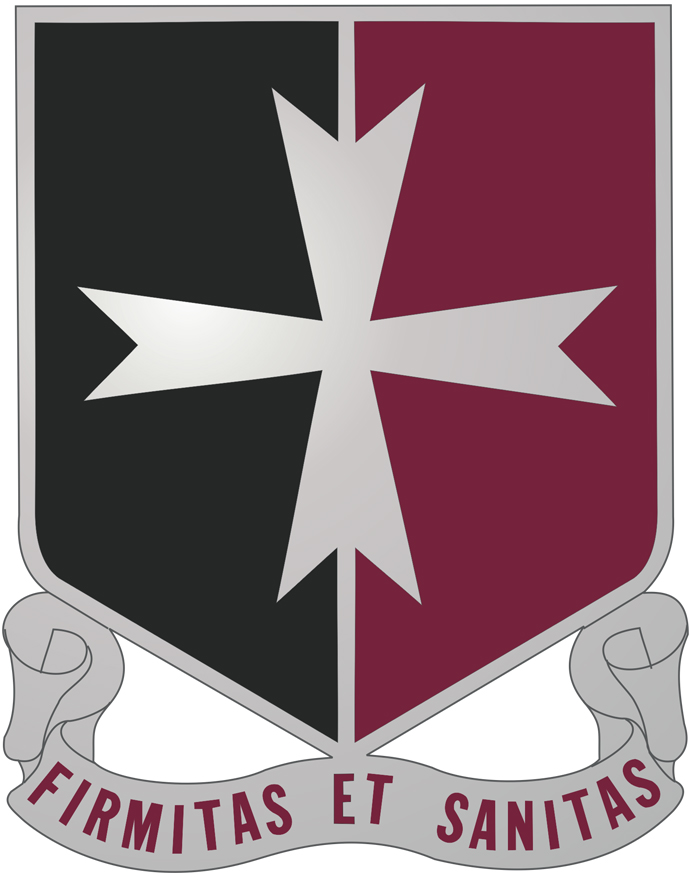
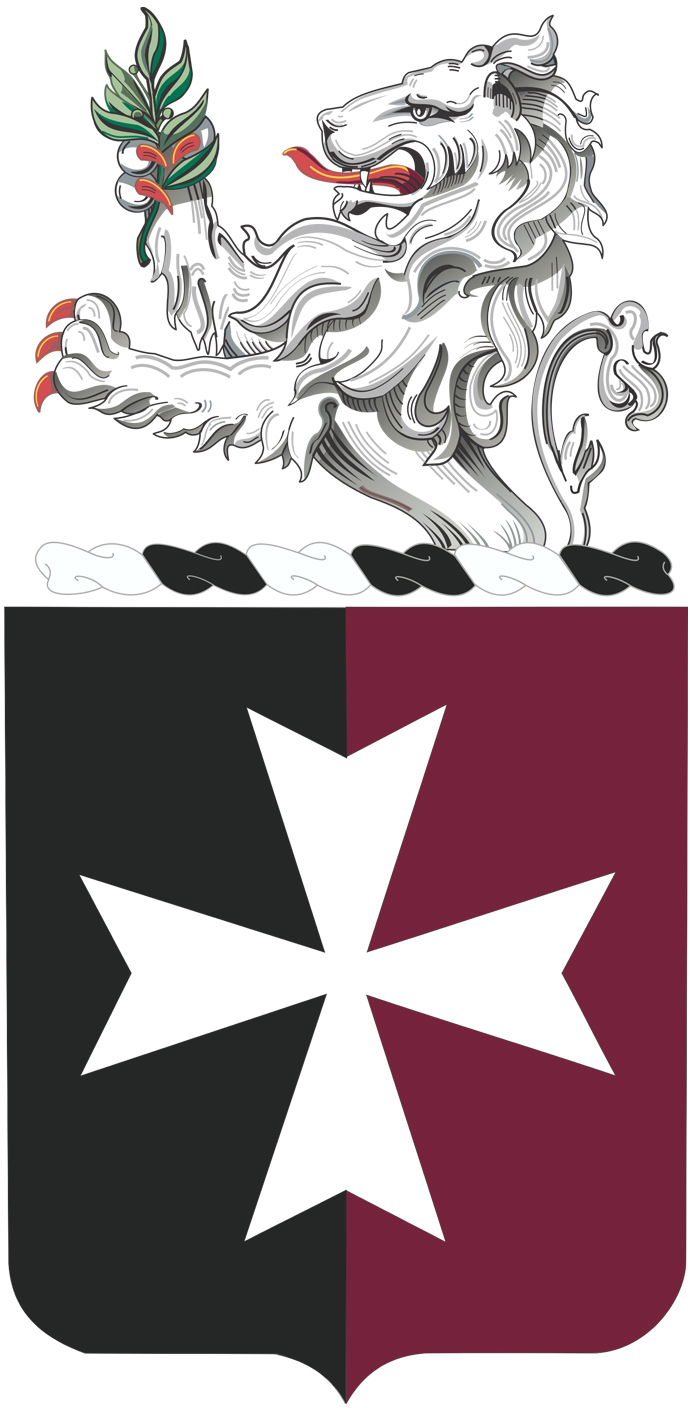
Active: Organized and Federally recognized April 27, 1927 in the Ohio National Guard at Columbus as Headquarters Company, 3rd Battalion, 166th Infantry, an element of the 37th Division. Reorganized and redesignated February 15, 1968 as Company E, 113th Medical Battalion, an element of the 38th Infantry Division.
Decorations: Philippine Presidential Unit Citation, Oct. 17, 1944 to July 4, 1945
Unit Nickname:
Unit Motto: "Strength and Health"
Home Station: MuncieBLAZON: SHIELD: Parti per pale sable and sanguine a Maltese cross argent. CREST: That for the regiments and separate battalions of the Indiana Army National Guard: On a wreath of the colors argent and sable, a demi-lion rampant argent, holding in dexter paw a laurel branch vert. MOTTO: FIRMITAS ET SANITAS (Strength and Health).SYMBOLISM: Maroon and white are colors traditionally associated with the Medical Corps, the branch of service of the parent organization. The white Maltese cross on a black shield is representative of the Knights Hospitallers of St. John of Jerusalem, an organization formed in Jerusalem during the Crusades in 1118, to attend the sick and wounded. This organization represented the first exclusively military medical unit in history. Black and maroon, with the white Maltese cross surmounted on the shield, signifies the similarity between the duties of the original medical organization and the duties of those which presently exist. BACKGROUND: The coat of arms was approved for the 113th Medical Regiment, Kentucky and Indiana National Guard, March 22, 1924 and redesignated for the 113th Medical Battalion, Oct. 10, 1942; amended to delete the crest of the Kentucky National Guard, Jan. 30, 1959; redesignated for the 113th Support Battalion with the symbolism revised, Nov. 10, 1992. The distinctive unit insignia was originally approved for the 113th Medical Regiment, Kentucky and Indiana National Guard on June 30, 1926 and redesignated for the 113th Medical Battalion on Sept. 29, 1942. It was redesignated for the 113th Support Battalion with the description and symbolism revised on Nov. 10, 1992.
Sources: Department of the Army, The Institute of Heraldry; U.S. Army Center of Military History, Department of the Army Lineage and Honors, 285th Medical Company.
Units
- Headquarters and Headquarters Company (HHC), 113th BSB, Muncie
- A Company (Transportation), 113th BSB, Muncie
- B Company (Maintenance), 113th BSB, Richmond
- C Company (Medical), 113th BSB, Anderson
Mission
To provide logistics, maintenance, and force health protection to an Infantry Brigade Combat Team (IBCT). The Headquarters and Headquarters Company (HHC) unit mission is to provide mission command, staff planning, supervision and field feeding support for all organic assigned or attached units to the Brigade Support Battalion (BSB). The Distribution Company mission is to provide transportation and supply support to the IBCT. The Field Maintenance Company mission is to provide field level maintenance support to an Infantry BSB for all automotive, ground support equipment, communications-electronic, armament peculiar systems and limited recovery support. The Medical Company mission is to provide Echelon II medical care to supported maneuver battalions with organic medical platoons. This company provides both Echelons I and II medical treatment on an area basis to those units without organic medical assets operating in the brigade support area (BSA). The Forward Support Company mission (Calvary Squadron) is to provide field feeding, transportation, supply support and field maintenance including communication equipment and COMSEC equipment to the Fires Battalion. The Forward Support Company Mission (ENG BN) is to provide field feeding, transportation, supply support and field maintenance including communication equipment and COMSEC equipment to the Engineer Battalion (ENG BN). The Forward Support Company Mission (FA BN) is to provide field feeding, transportation, supply support and field maintenance including communication equipment and COMSEC equipment to the Fires Battalion. The Forward Support Company Mission (INF BN) is to provide field feeding, transportation, supply support and field maintenance including communication equipment and COMSEC equipment to the Infantry Battalion.
History
World War I and World War II
The 113th Brigade Support Battalion (BSB) traces its organizational roots to Camp Shelby, Mississippi in 1917 as a medical unit associated with the Michigan National Guard, then deployed to Europe to fight in World War I. Demobilized in Feb., 1919 at Camp Zachary Taylor, Kentucky, it was reconstituted in the Indiana and Kentucky National Guard as the 113th Medical Regiment and assigned to the 38th Division. The horrors of World War I in Europe gave the soldiers courage and experience that would serve them well in another world war on the other side of the globe less than a quarter of a century later.Reorganized in 1942 as the 113th Medical Battalion, the unit served with courage, honor and distinction, caring for wounded comrades on the bloody shores of faraway lands with names that ring with the echo of some of the fiercest fighting in the Pacific: New Guinea, Leyte, and Luzon. Our distinguished service and courage under fire in the Pacific resulted in a Philippine Presidential Unit Citation. After answering the call to arms with honor and distinction, the unit was deactivated in Camp Anza, California and reorganized and federally recognized in the Indiana Army National Guard with headquarters in Lafayette.
Modern Operations
- In response to a growing need for logistical support within the 38th Division, the unit was converted and re-designated in 1993 as the 113th Support Battalion. After 61 years of distinguished service and association with the Cyclone Division, the unit was selected to serve as the BSB of the 76th Infantry Brigade in 1994 and headquartered in Columbus, Ind. shortly thereafter. The 113th BSB deployed with its brigade headquarters to Afghanistan from July 2004 to August 2005, in support of Operation Enduring Freedom, Phoenix III. In July 2007, the battalion headquarters was officially relocated to its current location of Muncie, Ind.
- In 2008, the BSB again deployed with its brigade headquarters, the 76th Infantry Brigade Combat Team, to Iraq in support of Operation Iraqi Freedom (December 2007 – December 2008). The unit was split across the brigade and provided a convoy security company, maintenance teams and medic support. The remaining headquarters augmented and supported the brigade headquarters mission of a mayor’s cell in Balad, Iraq and as Task Force 113 coordinating all aspects of base defense planning and execution to include direct control of base security forces on Contingency Operating Base (COB) Q-West.
Source: 76th IBCT
- 776th Brigade Engineer Battalion (BEB)
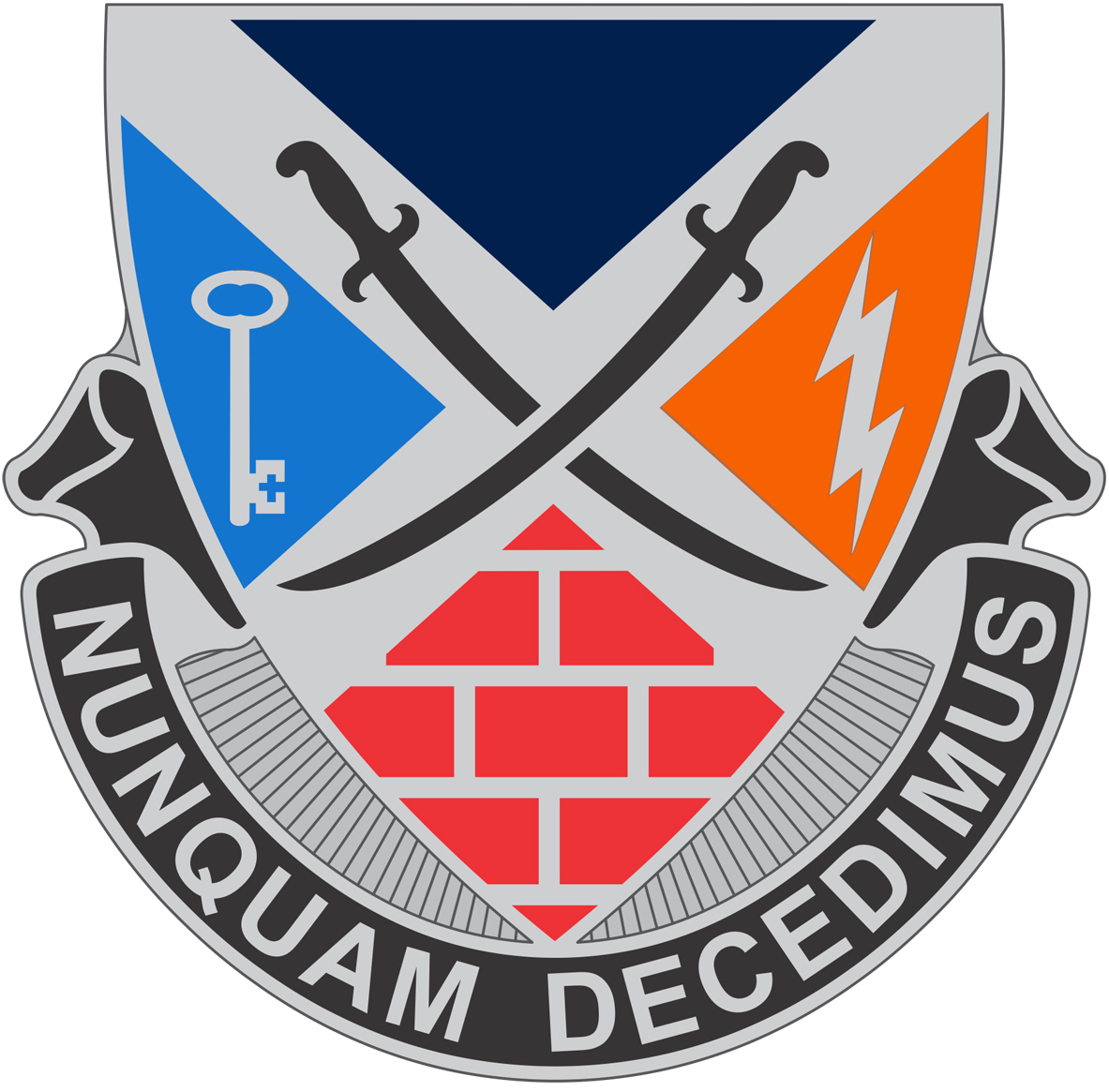
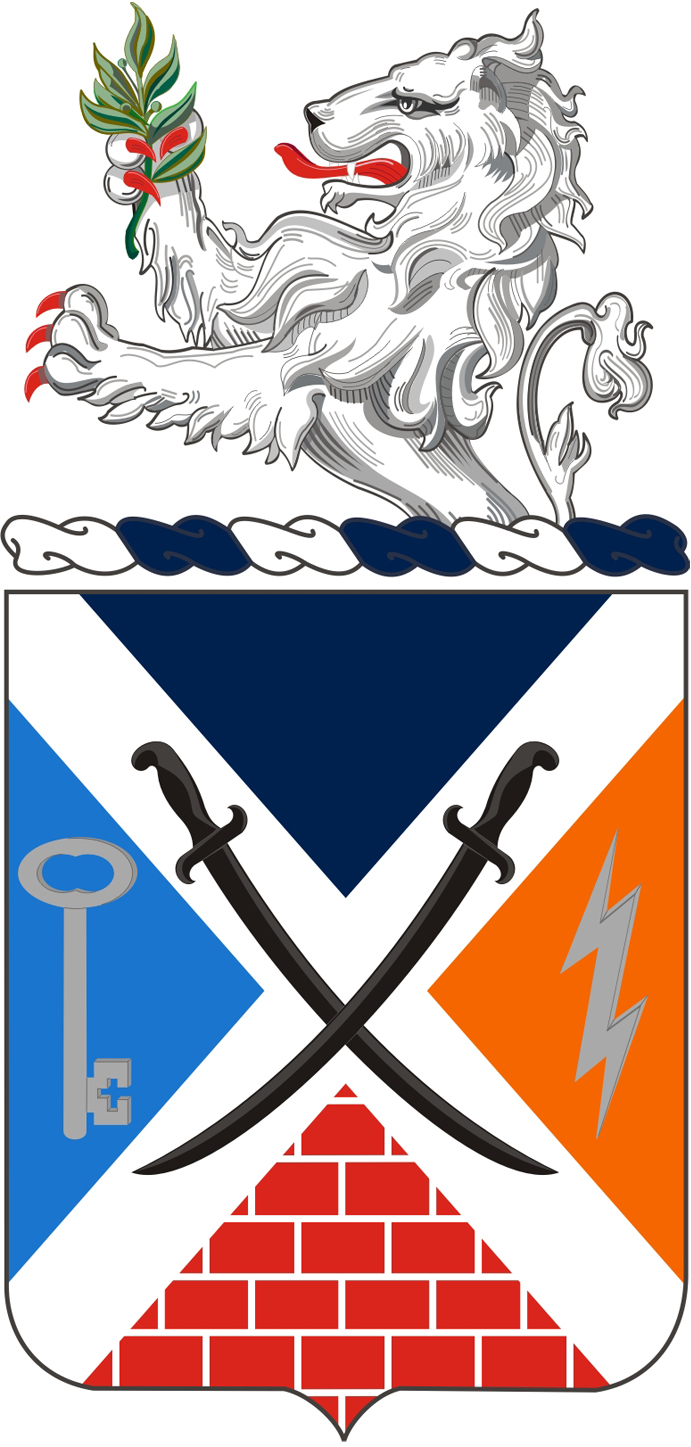
Active: June 30, 1947Decorations: Philippine Presidential Unit Citation, Oct. 17-July 4, 1946 - Company A, Winchester and Company C, Greenfield
Unit Motto: "We Never Quit"
Home Station: LawrenceBLAZON: Quartered per saltire azure, tenné, gules masoned argent and celeste, on a saltire of the fourth, flanked in dexter by a key in pale, wards downward and inward and in sinister a lightning bolt palewise argent, two scimitars in saltire points downward sable. Attached below a black scroll inscribed “NUNQUAM DECEDIMUS” in silver. SYMBOLISM: National flag blue is the color traditionally associated with Infantry units, referring to the unit’s past and present branch affiliation. The following colors and its symbols represent the unit’s communications capabilities; the masoned scarlet suggests the Engineer functions; and oriental blue and the key indicate the Military Intelligence responsibilities and the ability to be “First to Know.” The saltire alludes to cooperation. The crossed scimitars symbolize military readiness and the Battalion’s participation in Southwest Asia. The motto translates to “We Never Quit.” BACKGROUND: The coat of arms and distinctive unit insignia were originally approved for the Special Troops Battalion, 76th Infantry Brigade Combat Team on July 1, 2008. It was redesignated for the 776th Engineer Battalion with the symbolism revised effective Sept.1, 2014.
Source: Department of the Army, The Institute of Heraldry
Units
- Headquarters and Headquarters Company (HHC), 776th BEB, Lawrence
- A Company (Combat Engineer), 776th BEB, Winchester
- B Company (Combat Engineer), 776th BEB, LaPorte
- C Company (Signal), 776th BEB, Lawrence
- D Company (Military Intelligence), 776th BEB, Stout Field
- Detachment 1, D Company (Shadow), 776th BEB, Camp Atterbury
- E Company, 113th Brigade Support Battalion (BSB), Lawrence
Mission
To command, control and sustain organic and attached units in support of the Infantry Brigade Combat Team (IBCT) commander and staff. The Headquarters and Headquarters Company mission is to provide mission command (MC) and supervision of the tactical operations of the Brigade Engineer Battalion (BEB), IBCT and all assigned/attached Operational Control (OPCON) units. The Combat Engineer Company mission is to increase the combat effectiveness of the Brigade Combat Team (BCT) by accomplishing mobility, countermobility, limited survivability and sustainment engineer mission. The Brigade Signal Company mission is to provide 24-hour operational command, control, communications, computer, intelligence, surveillance and reconnaissance (C4ISR) signal systems network to the supported Heavy/Infantry Brigade Combat Teams (A/IBCTs), which includes deploying, installing, operating and maintaining these systems. The Military Intelligence Company mission is to provide timely, relevant, accurate and synchronized Intelligence, Surveillance, and Reconnaissance (ISR) support to the maneuver units within the BCT/BCT commander, staff and subordinates during the planning, preparation and execution of multiple, simultaneous decision actions on a distributed battlefield.
History
Special Troops Battalion, 76th Infantry Brigade Combat Team (now 776th Engineer Battalion) is credited with participation in the following campaigns:
- War on Terrorism: Iraq, Iraqi Surge and National Resolution
- World War I
- World War II (New Guinea, Leyte, Luzon)
View Lineage and Honors for details of campaigns and decorations.
- About the U.S. Army Regimental System
Excerpt from The U.S. Army Regimental System, Army Regulation 870–21:
For much of the Army’s history, the regiment was a tactical as well as an administrative and ceremonial organization, but in the late 1950s the Army reorganized its regiments to meet the requirements demanded by highly mobile warfare with greatly increased firepower and high casualty rates.
Between 1957 and 1959, the Army eliminated the regimental headquarters as a tactical and administrative organization from most of its combat arms regiments (except some cavalry regiments). However, the Army was determined to retain the history, traditions, and ceremonial function of the regiment in the new structure. The result was the Combat Arms Regimental System designed to allow perpetuation of combat arms regimental history, ceremony, and traditions in the new tactical organizations without restricting the organizational innovations of the future.
In 1984, the Combat Arms Regimental System was expanded to include the non-combat arms branches with the advent of the United States Army Regimental System (USARS). Under USARS, non-combat arms branches were incorporated under the “whole-branch” concept in which the entire branch corps provided a regimental-model historical bond.
USARS provides Soldiers with a sense of tradition and a connection to the past, while continuing to enable the Army to evolve and adapt to current and future requirements.
In short, the USARS bridges the traditional role of the regiment with the tactical mission of the modern Army. The USARS serves as the basis for unit history and lineage and for the consistent naming of battalions, squadrons, groups, separate companies, batteries, and troops of combat arms regiments, while perpetuating the regimental history of the Army.
Through USARS, unit and organizational histories, lineage, and honors are perpetuated. In addition, USARS provides each current and former Soldier continuous identification with a regiment, a corps, or a special branch. The USARS mission is to enhance Army esprit de corps and pride, as well as impart a keen understanding of its past, through a framework that provides the opportunity for affiliation, develops loyalty and commitment, fosters an extended sense of belonging, improves unit cohesion, and institutionalizes an Army ethos.
Leadership
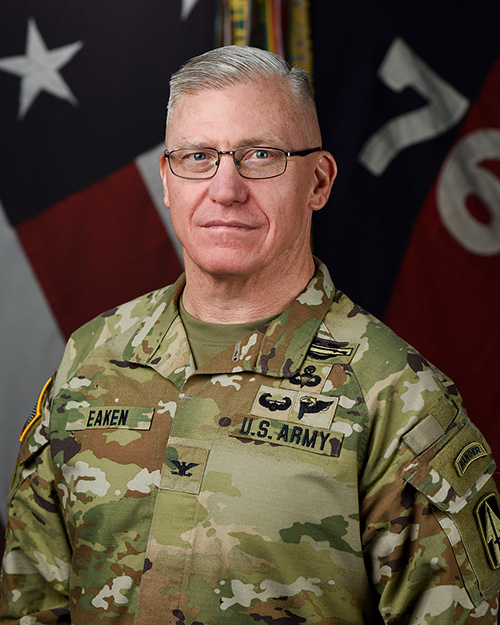
Col. Shawn Eaken
Commander, 76th Infantry Brigade Combat Team
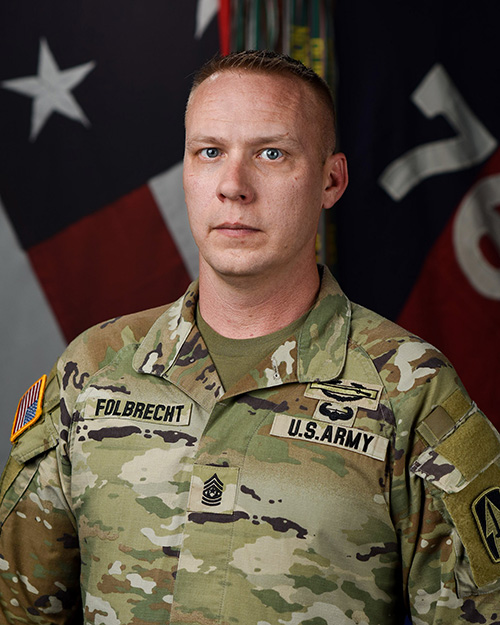
Command Sgt. Maj. John Folbrecht
Senior Enlisted Advisor, 76th Infantry Brigade Combat Team
News Releases
Loading news items...


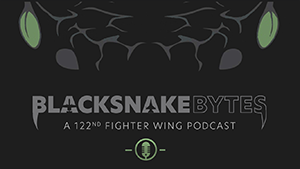
Contact Us
Headquarters
76th Infantry Brigade Combat Team
9920 East 59th Street
Indianapolis, Indiana 46216-2256
Phone
Brigade Adjutant (S1)
317-247-3300, ext. 87606
